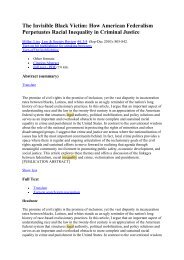Ski – resort and regional development: profile of visitors ... - E-Journal
Ski – resort and regional development: profile of visitors ... - E-Journal
Ski – resort and regional development: profile of visitors ... - E-Journal
You also want an ePaper? Increase the reach of your titles
YUMPU automatically turns print PDFs into web optimized ePapers that Google loves.
12<br />
Carmel Foley <strong>and</strong> Bruce Hayllar<br />
p.408) <strong>and</strong> under these conditions there is reduced scope for the <strong>development</strong> <strong>of</strong> a sense <strong>of</strong><br />
community (Parker, 2004; Grant, 2006).<br />
APPROACHING THE DATA<br />
In this paper we explore the notion <strong>of</strong> community in the context <strong>of</strong> McMillan’s (1996)<br />
conceptualisation. This exploration arose in a grounded way from the narrative <strong>of</strong> the two<br />
groups <strong>of</strong> participants in the study. One group reported that a sense <strong>of</strong> community was a<br />
special <strong>and</strong> attractive feature <strong>of</strong> caravan park holidays; a feature they believed to be missing<br />
in other types <strong>of</strong> holidays. The second group appeared to have a less developed sense <strong>of</strong><br />
community, despite the reports <strong>of</strong> the importance <strong>of</strong> the friendships among the group members.<br />
We attempt to describe, in the first instance, ways in which a sense <strong>of</strong> community was<br />
manifested for the participants in the first group, <strong>and</strong> to determine the factors that contribute<br />
to the experience <strong>of</strong> community. Secondly, we aim to develop an underst<strong>and</strong>ing <strong>of</strong> the reasons<br />
that the second group had a less developed sense <strong>of</strong> community. Through this analysis we<br />
hope to provide some insight into the ways in which this form <strong>of</strong> tourist experience can<br />
contribute to the production <strong>of</strong> social capital.<br />
METHODOLOGY<br />
The Study Sites<br />
The study took place at two caravan parks; one on the south coast <strong>of</strong> New South Wales,<br />
Australia, <strong>and</strong> the other in far north Queensl<strong>and</strong>.<br />
The New South Wales park is situated at the mouth <strong>of</strong> a river that provides caravan park<br />
patrons with direct access to the water. Boat launching ramps, swimming areas on the lagoon<br />
<strong>and</strong> the nearby beaches provide substantial opportunities for water-based recreation including<br />
swimming, enclosed water <strong>and</strong> deep-sea fishing, SCUBA diving <strong>and</strong> surfing. The park’s<br />
locality also provides relatively easy access to national parks, state forests <strong>and</strong> smaller towns<br />
<strong>and</strong> villages in the coastal hinterl<strong>and</strong>. In addition to these natural attributes, the caravan park<br />
is adjacent to a commercial area containing a range <strong>of</strong> tourist related services <strong>and</strong> infrastructure<br />
including local fast food outlets, restaurants <strong>and</strong> cafes, a small cinema, a bowling <strong>and</strong> returned<br />
servicemen’s club, <strong>and</strong> a branch <strong>of</strong> a national supermarket chain. At peak periods, typically<br />
during the school holidays, up to seven hundred <strong>and</strong> fifty people will reside in the park.<br />
While the management has changed many times, the site itself has been used for camping<br />
holidays for more than 60 years. (Indeed, some <strong>of</strong> the participants in the study have been<br />
visiting the park for that length <strong>of</strong> time.) The park has evolved from a local government<br />
controlled camping ground to a modern ‘<strong>resort</strong> style’ establishment with a mixture <strong>of</strong> camping<br />
<strong>and</strong> caravan sites, cabins <strong>and</strong> ‘villas’, a recreation hall, swimming pool , a ‘jumping pillow’<br />
<strong>and</strong> programmed children’s activities. It is clean, clearly laid out <strong>and</strong> appears to be well<br />
maintained. Peak season for this park is the southern hemisphere summer, particularly the<br />
December-January school holiday period.<br />
Tourism Today - Fall 2007 - Full Paper














